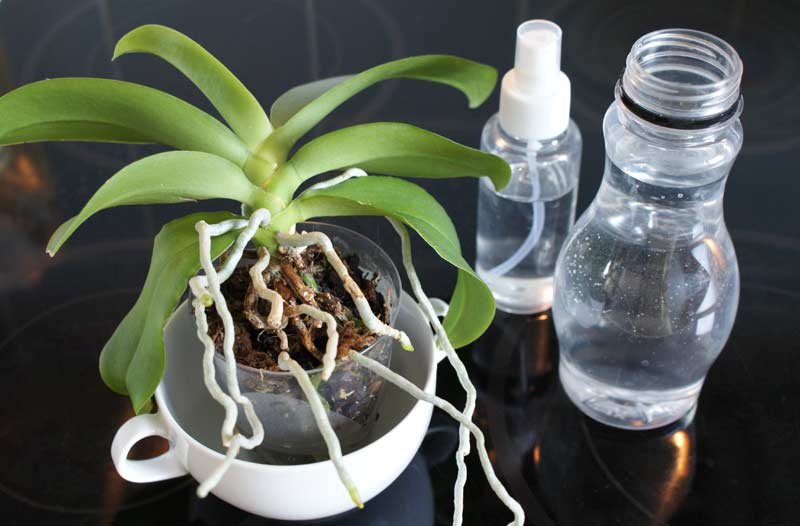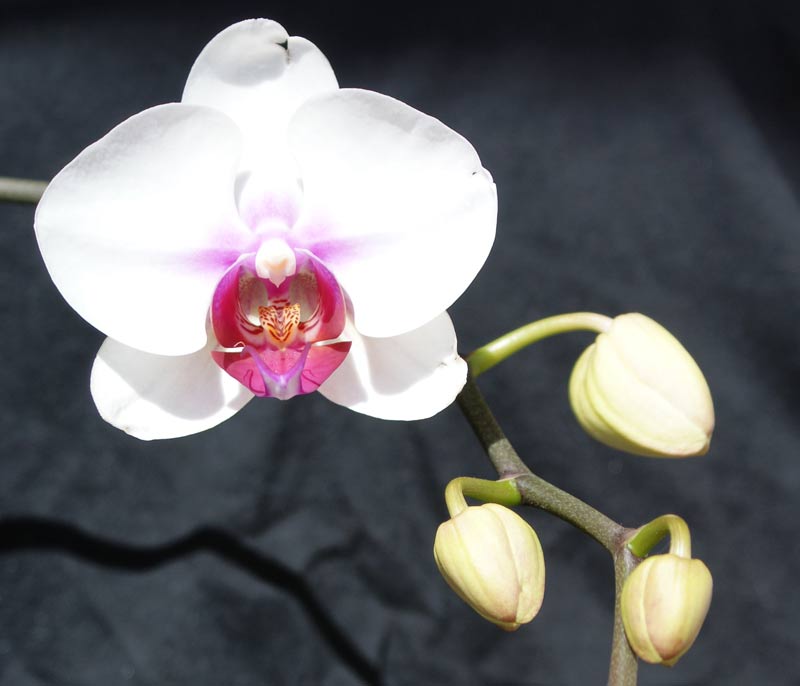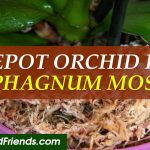
** This post is written and edited by a human being **
I still remember when I brought my first orchid home; a white phalaenopsis orchid rescued from a dumpster. I had no idea how to water it.
And as I started to look into it, I felt overwhelmed and discouraged. For a moment, I thought maybe orchids aren’t for me, as I don’t like plants that are too complicated to look after.
It can feel like a challenge for anyone still new to orchids. And some people think they know what they’re doing, but end up losing their orchid anyway due to insufficient watering.
So it’s essential to learn how to do it properly because once you get the hang of it, you can keep your orchids alive for many years to come.
The key to watering your orchid is to let it dry in-between waterings. If the media (bark/moss) looks still wet, or there is humidity inside the pot, do not water yet. Keep checking, and as soon as the media appears dry, it’s time to water again. Root color is another indicator; green roots mean they’re still hydrated. And silvery-grey roots mean they need water.

Orchids grow in trees
Money doesn’t grow on trees, but orchids do!
Before we go into more detail about how to water orchids, it’s important to understand one thing: orchids differ from ‘normal’ houseplants because they’re epiphytes.
Epiphytes are plants that live on other plants, like trees. They’re not parasitic, though, meaning they don’t suck nutrition from their host plant nor harm it in any way. They simply live on it, absorbing moisture and nourishment from the air and rain, as well as from the water running down the debris.
As they live on other plants, they don’t grow in soil. Meaning, their roots are different from the roots of ‘normal’ houseplants. They need air, and so potting an orchid in soil would ultimately suffocate and kill it.
Soil retains more moisture than bark pieces used for potting orchids, which is the reason orchids acquire such a different way to water them, than what ‘normal’ houseplants do.
The soaking method
The soaking method is perhaps the most used watering method for indoor orchids. It is a safe and easy way to water them.
Once you have detected it’s time to water your orchid again, take it out from its decorative pot and put it inside a container of some sort – a bucket, even your kitchen sink will do.
Now, fill up the container with enough water to almost reach the edge of the orchid pot, or even just half-way. Let it stand for 15 minutes or so.
To leave it longer won’t cause any harm. You want the bark pieces to absorb enough water to make them moist again.
Once it’s time to remove your orchid, lift it up from the container and let the excess water drip out from the holes in the bottom of the pot.
Then put it aside to let it drip some more. Once all the excess water has leaked out, it’s time to put your orchid back on its place.
Watering your orchid from above
You can pour water inside the pot, or put it under a running tap – however, it’s vital not to get any water on the orchid itself.
Orchids are prone to rot, so if water goes in the crown or in-between the leaves, it will start to decay over time. So if you choose this method, please be very careful not to get any water on the orchid itself.
Watering from above doesn’t retain water as thoroughly as the soaking method does. But, there are instances when you don’t wish the potting media to be thoroughly wet, like if your growing conditions are very humid.
Or you’ve noticed some pots retain moisture for more extended periods of time. Maybe the media you’re using takes ages to dry out. Or you’ve detected some fungus gnats in the media, which thrive in moist conditions.
In those scenarios, it’s a good option to water your orchid from above. That way the roots get the water they need, without making the whole media soaking wet.
Orchids on ice
You might have heard about ice cubes being used for watering orchids. This is a new and somewhat controversial topic. Growers place 1-3 ice cubes on top of the orchid media every or every other week.
Orchids are exotic plants and therefore don’t experience cold temperatures in their natural habitat—let alone ice! Contact with an actual ice cube, if it doesn’t instantly melt, is a significant stressor to your plant.
You can decide whether you want to try this method and see if it works for you. But if you do, please keep a close eye on your orchid. If you see any signs of struggle, then switch to another watering method mentioned above.
What kind of water to use for watering orchids
Regardless of the source of your water, one rule applies to all; Temperature-wise the water should always be lukewarm, or room-temperature. Not hot, not cold.
Tap water
Tap water is okay to use as long as it’s not too hard, which varies from location to location.
Checking for mineral buildup around water fixtures like showerheads and taps is one way to tell if your tap water is hard.
If you detect a lot of white and/or rusty chalky matter, then you know the water is hard.
You can also buy PH measuring devices that tell you the exact figures of hardness/softness of your tap water. You want the water to have medium-hardness with PH level of max 7,5.
If you know the tap water in your area is not safe for human consumption, then perhaps you should directly look into other water sources for your orchids too.
Every municipal should provide an annual water report, which is definitely of interest if you’re not sure about the quality of your tap water. Fluoride, chloride, heavy metals – there are several things to look out for.

Rainwater & Distilled water
Many orchid lovers opt for rainwater or distilled water. They’re both soft waters, and therefore safe to use.
However, as neither of them contains any minerals, it’s crucial to add fertilizer to them. This is to give your orchid the nutrition it needs – your orchid doesn’t need only water, but water and nutrition!
Rainwater can be collected simply when it rains, which takes some planning. If you live in an area where it rains more often than not, then this might be a sustainable option for you. And it’s free!
Distilled water is better for people who live in a place where it doesn’t rain often or who don’t want to depend on Mother Nature.
If distillers are something you’re interested in, you can buy them locally or online. They’re pretty easy to use and provide clean drinking water not only for your orchids, but for you as well.
Aquarium water
If you have a freshwater aquarium, you can use water from it too. It provides excellent nutrients for your orchids, with no additional fertilizers needed. Just make sure to keep up with your tank’s PH-levels and water changes.
A set watering schedule
Some people have set days to water their orchids, but to have a fixed watering schedule will backfire over time. Just because your orchid’s water needs aren’t the same throughout the year.
During summer, as the weather is warmer, the potting media dries out quicker. You can find yourself watering once a week or even every 5 days. And during colder winter days, it might take weeks for the media to dry out.
So it’s not recommended to stick with one watering schedule, because it just doesn’t work for the whole year.
You need always to keep an eye on your orchids, and adjust the watering accordingly.
If the weather is stable, the water needs are pretty much the same for the time being – but as soon as the season changes, you need to readjust once again.
So make it a habit to keep checking the pots!
Misting your orchids
Orchids thrive in a humid environment, so if your indoor air is very dry, you can occasionally give a little misting to your orchids.
Especially with aerial roots (the roots that grow in the air), it’s good to provide them with a bit of misting every now and then, to avoid them from drying out.
Personally, I prefer spray bottles with a very fine mist. But regular spray bottles are fine too. Just make sure not to spray a lot of water in the crown or in-between the leaves, to avoid future rotting.
If it’s sunny and there’s good air circulation in your orchid room, then the excess water dries out quicker. Otherwise mist with caution.
In addition, you can add a humidifier by your orchids or build a humidity tray. You can read more about humidity trays HERE.
Conclusion
We have now covered how to tell it’s time to water your orchid again; the different methods to water your orchid; and what kind of water to use. We also talked about watering schedules and misting orchids.
I hope you found this article helpful. Bye for now, and thank you for reading.
Happy watering, orchid friends!





Thanks for all the great info!
You welcome, Linda! Thanks for reading. 🙂
Hi Irene thanks for the info, I need some help i have a orchid that that a pretty advanced flower spike , my estimation is the buds will open towards the end of October, I now have an infestation of fungus gnats, could i re-pot at this stage or should i wait till after the flowers and use an insecticide
Hi Ronald!
Oh, fungus gnats. Luckily they’re more annoying than harmful!
Personally, I wouldn’t repot the orchid now, because you risk losing the bloom. It might not happen, but it’s a chance to take!
There are a few things you can do though;
1. Make sure the potting medium dries properly before watering again.
2. Are you using a decorative pot? If yes, remove it and let the orchid stand (in its pot) in open air.
3. Would it be possible to gently add some air holes in the pot without damaging the roots? Even just a few (holes or cuts, doesn’t have to be pretty!) to add air-circulation!
I actually have a whole article about fungus gnats, which you can see HERE ~ maybe you’ll find some more tips there! 😊
Good luck! Luckily this issue is fixable!